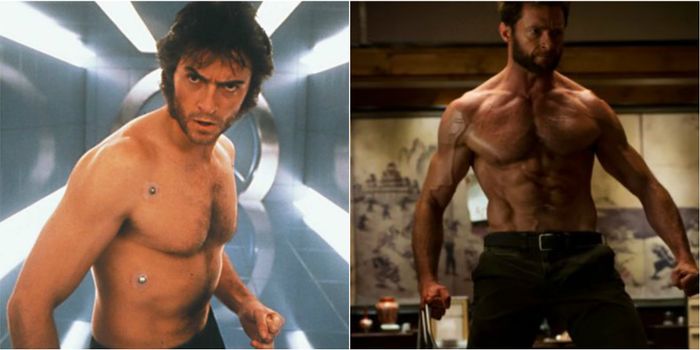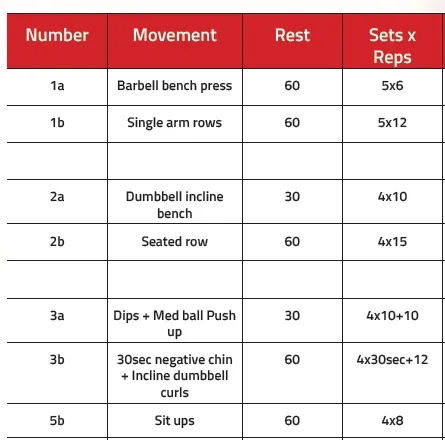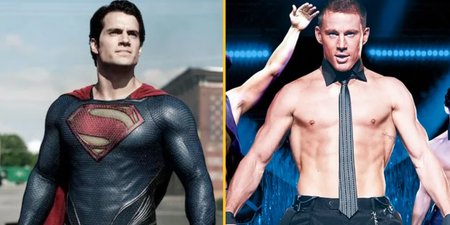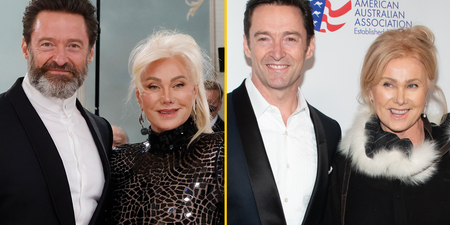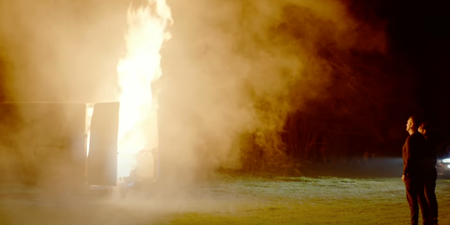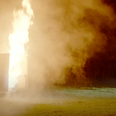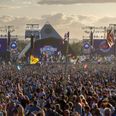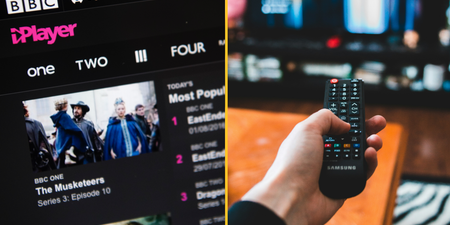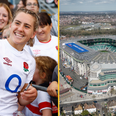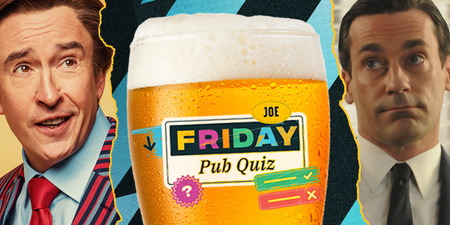Hugh Jackman gets in truly unbelievable shape to play X-Men character Wolverine.
The Australian actor has somehow manages to develop his physique to become bigger and better with every on-screen incarnation of the badass mutant.
The 47-year-old is now deep in training for Wolverine 3 out in the US – and it’s rumoured to be the last time he’s going to star as the adamantium-clawed hero.
So you know when the film comes out in 2017 that he’s going to be in the best condition of his life.
One man who knows just how Jackman has added thick slabs of muscle to his frame while getting freakishly shredded is trainer David Kingsbury who has worked with him on many X-Men films.
https://www.instagram.com/p/BISIpEkATwX/?taken-by=teamkingsbury
The British PT is the go-to guy for Hollywood A-listers getting jacked for the next big blockbuster role – and he has worked exclusively to shape Wolverine’s iconic physique over a number of years.
Kingsbury has given JOE an insight into how Jackman has build that incredible body, the training that has has him deadlifting 410lbs and the diet that has got him super-lean.
This is how he did it…
JOE: You’ve worked with Hugh Jackman multiple times – so he knows your methods and you know him inside out. How do you keep progressing and building him bigger and better all the time?
David Kingsbury: It comes with time. For most people, the more months and years they put into it, if they’re doing it in the right way and working progressively, it’s just a case of building over time. The key is just being progressive and consistent with your training
https://www.instagram.com/p/BIa4hRqg5FX/?taken-by=teamkingsbury
You started working with him a couple of years ago, how has he changed in the time that you’ve been working with him?
We did some changes to the training and the food as well. So we incorporated a lot of the bigger and heavier lifts to improve his strength. That then allows you to lift more for the muscle-building sets – as you’re boosting your strength, you’re going to be boosting your capacity to lift heavier weights for higher reps.
Is that something you introduced into his training?
He had already been training for however many years before I started with him. But it was a slight change in terms of prioritising that kind of stuff, yes.
He had done heavy stuff before, but not progressively and not prioritising it. So he was focussing on the big lifts like deadlifts, squats, bench press and pull ups.
You’re targeting large muscle groups, so you’re targeting strong muscle groups which can generate a lot of force.
Therefore you’re able to lift quite a lot of weight – part of that is the training volume which stimulates muscle development.
https://www.instagram.com/p/2iuRpBChHc/
Where did you start putting together a plan for Hugh – as I imagine all your Hollywood clients have different abilities and different goals.
The first film I did with him was Les Miserables. The first thing we talked through was what he was looking to achieve with the character.
There were two distinctive looks he had to go for (in the film) – one was lean and gaunt, but still strong. The other one was just bigger and healthier. We had to transition between those. So the training was just tailored towards that.
What did his programme look like in terms of how many days he was training?
We train in different phases – so one phase where we’re building lean muscle and then we train in another phase for dropping body fat. So they’re two different phases and they will last anywhere from eight to 12 weeks each – maybe longer.
We sometimes do 16 weeks for the lean muscle phase before we go into the fat cutting phase. It depends how long we have.
The longer you get with someone, the better results you can achieve.
The weight training is almost identical in both phases. The only difference really is the amount of cardio and the amount of calories. It’s really simple.
https://www.instagram.com/p/BHMt-WOj5Rs/
What does the training look like then?
We work through all the main lifts. We start with heavy sets, working around the five to six rep range for the big movements. Then after we’ve done four or five sets on those, we will move onto slightly higher reps – but using similar movements.
We might do four to five sets of 10-12 reps there. Then we go onto slightly more intense circuits of resistance movements where we’re working on two exercises back to back, for example, using higher rep ranges of around 15 reps.
How does this work?
You do your heavy stuff first because it’s the highest resistance. You have to make sure you’re warmed up first. Because you don’t want to do this when you’re fatigued, because you won’t get anywhere near the same amount of weight lifted and the risk would be much higher.
Then you progressively work lighter because it suits the energy pattern of the session, but also to get the best results it’s good to work in all rep ranges.
Does this work your muscle in different ways then in terms of hypertrophy?
Yes – myofibril and sarcoplasmic. Which is why you target different rep ranges in the session and work through different rep ranges, because each of them has a benefit.
https://www.instagram.com/p/BIXXAnwDLPU/?taken-by=thehughjackman
That’s interesting because some people will split this and do heavy days and light days.
You can gain muscle or lose muscle on the same training plan, depending on your calories. So if you give someone a muscle building plan and put them on a calorie deficit plan they will lose weight. Whereas if you put them on a muscle building plan with a calorie surplus then they will gain weight.
So nutrition is the most important thing.
So in the bulking phase do you do a lean bulk?
We try and keep it as lean as possible, because for these guys you’re working with A-listers so they have other commitments. So you can’t have them turning up with excess body fat if they’ve got a shoot for Vogue, or you can’t have them out of shape for a film premiere. So they always have to stay lean to an extent, so you can’t push the body fat up too high.
You just have to eat healthy foods. You just have to find the right calorie surplus so that you’re building lean muscle without storing excess fat.
The cleaner you do it, the better results will be. But you just have to find that magic number where they’re going to be gaining muscle but not too much fat.
The more training you do, the more you have to eat – because every time you train, you’re burning calories. So you have to take into account every session in terms of calories spent, then you have to pay yourself back with those as part of your food plan.
Does carb cycling feature in these plans?
Yes we do carb cycling, depending on our training days. Sometimes you wouldn’t carb cycle particularly, you’d just do a couple of low carb days.
So if you trained five days in a row, we wouldn’t necessarily carb cycle on those. Sometimes we would, but we may go five carb days and then drop carbs lower for one day at the weekend for example.
Whereas if we had a Wednesday off we might go carb, carb – low carb – carb, carb. The key reason for doing it is improving insulin sensitivity. You’re improving your body’s ability to deal with carbohydrates and how you utilise them.
It’s really important for building muscle – and it’s even more important for building lean muscle.
So on low carb days are you just increasing his intake of good fats to compensate?
Yes. So they will be much higher fats on the low carb days, because you still have to hit a certain amount of calories. So it means eating lots of avocados, nuts and seeds.
What kind of foods is he eating?
It’s really simple things. So breakfast would be oats, eggs and rye bread with peanut butter. It was four meals a day for the most part. Then it might be fish, rice, green veg with avocado or steak or chicken (instead) with the rice, green veg and avocado.
We’d probably keep the carbs closer to training time. So if we trained in the morning we’d keep the majority of carbs earlier in the day, then you just have slightly less in the evenings.
So other carbs we’d have are sweet potatoes, rice and oats would be the main ones.
https://www.instagram.com/p/BHepgG_jf5s/?taken-by=thehughjackman
So I imagine he’s on pretty high calories in the bulking phase?
Yes. You have to consider a lot of things when you work out someone’s calories. Their height, age weight and activity levels. Then you can figure out what their BMR (Basal Metabolic Rate) is, so how many calories they’re burning at rest. Once you’ve got that number and then worked out how many training sessions they’re doing, then you can determine what their BMR is plus their activity levels and finally from that you can add a percentage to give you a surplus – so you’re consuming more calories than you’re burning.
So it’s not unusual for me to have certain people on 4,000 to 4,500 calories per day during that phase. That means heavy meals.
So is the lean bulking just 12 weeks of progressive overload or will you do periodise and do micro training cycles within this?
It varies a little bit. We may do a strength phase, followed by a hypertrophy phase. Or we may just run strength throughout the whole phase for 12 weeks using progressive overload. It depends on the lifts a little bit. So on something like deadlifts we might keep them as strength all the way through.
Whereas an exercise we might move through from strength as a priority to hypertrophy as a priority further down the line.
This is a sample chest workout…
What happens when you start the cutting phase?
We incorporate some high intensity interval training and primarily some low intensity, steady state cardio and go into a calorie deficit where we reduce the calories.
The weight training doesn’t really have to change during that phase. It’s difficult to get stronger during a calorie cut. You can, because a lot of strength is actually central nervous system and the number of fibres you can recruit rather than just the strength of them.
So you potentially can get stronger, but I’d never really bother trying. Just focus on one thing at a time.
If you hit a PB lift during that phase – great. If not, it doesn’t matter – as long as you’re achieving the one goal that you need to hit which is ultimately looking a certain way on the day. It doesn’t matter if you’re lifting heavy weights or light weight.
Do you find it brings optimal results then by mixing up his cardio?
Yes definitely. I like to use both. A lot of people are in one or the other camp (HIIT or LISS) but I just think that they both have benefits.
I think overall, if you’re doing cardio and burning X amount of calories then it’s fine.
https://www.instagram.com/p/BGmD56nihMF/?taken-by=thehughjackman
What types of HIIT do you find work best?
We mainly stick to sprints and the bike. So for X-Men: Future Past we had a couple of spin bikes and just did intervals on that.
We do a mixture of intervals. We do some really short, sharp ones which will be like 10-15 seconds. Then slightly longer ones which might be 30 seconds to 45 seconds.
Depending on whether you’re looking for maximal force or maximal intensity, then you adjust the rest periods.
So for example if you’re doing a 10 second sprint with a two minute rest, then you’re going to be able to sprint again with maximal force. But if you do 30 second sprints followed by 30 seconds rest, then your sprint will be much weaker but the intensity if much higher.
One thing to consider when doing cardio is how much of an impact it’s going to have on the resistance training. That’s why a lot of the time, low intensity works so well because it has less impact on the resistance training – so it’s not going to fatigue you and you’re not going to be sore from it so it won’t restrict your training.
Resistance training is still the priority in this phase.
What are the keys to a transformation like this?
The key things would be determination – that’s the number one. You really have to want to achieve it, because there are going to be a lot of moments where you can fuck it up, basically, and you have to just not. So that’s where the dedication comes in. You have to really want it.
Consistency is one of the most important things too. So to get the best out of something you have to keep working and working at it consistently.
Then I would say, if we’re talking about a transformation as a whole then I would say nutrition. It is so important and not everyone is aware of just how important it is when you’re trying to change your body shape.
If you want to find out more about David’s online training programmes, visit www.davidkingsbury.co.uk.
https://www.instagram.com/p/BH1RhNaA7PB/?taken-by=teamkingsbury
